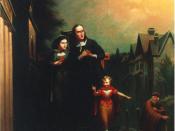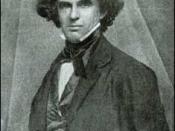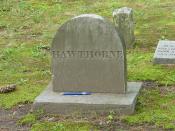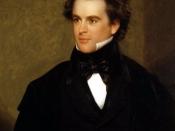Sin - (Noun) - Something regarded as being shameful, deplorable, or utterly wrong.
The subject of sin is one that Nathaniel Hawthorne explores in many of his works in great detail. The great American novelist portrays sin as a trait that can be forgiven in certain cases. The way in which Hawthorne portrays certain characters indicates how pardonable the characters' transgressions have been. This can be seen in many of his works, including The Scarlet Letter, and "The Birthmark."ÃÂ Within these works, Hawthorne describes some characters, such as Dimmesdale and Aylmer, as dark and guilty of their sins which he believes to be of a more severe nature. Other characters, such as Hester, are described in a compassionate manner, thus implying that her sin is excusable. This would lead one to believe that Hawthorne is sympathetic to some characters who have committed less severe sins.
Hawthorne's harshness towards some sinners as well as his sympathetic portrayal for other sinners may come from his background.
His grandfather, Judge Hathorne, helped convict innocent people during the Salem Witch Trials in 1692. Hawthorne believes that his grandfather sinned greatly. He was so ashamed of this act , that he went as far as to change his last name to Hawthorne to dissociate from him. He could not condone the fact that his grandfather, a judge, did not maintain the high moral standards Hawthorne felt he should have. This is why he portrays Reverend Arthur Dimmesdale in The Scarlet Letter as "...the greater sufferer"ÃÂ (Lynn 171). He, like Hawthorne's grandfather, is a respectful figure in the society. This figure should be the one that everyone looks up to, and should commit no sin. Dimmesdale, in committing adultery, "has failed to maintain the integrity of his character.... He cannot bear to think that he wears a disguise, that he cannot be the open, frank, stainless character he had from his youth aspired to be..."ÃÂ (Lynn 164). He has failed to be the role model that he hoped he would be. Hawthorne sees his sin to be hypocrisy. He is living a life of a respectable man of God, but in fact, he is a man of sin. Although, he is a minister and every week gets up on his pulpit to hear his congregation's sins, Dimmesdale is too weak to confess his own sin. As a result of his hiding his sin from the congregation, and all of society, he is adding hypocrisy to his sin. Therefore, Hawthorne portrayed Dimmesdale in a very dark and gloomy manner throughout the work. Hawthorne suggests that his sin of hypocrisy in addition to the sin of adultery is a more significant sin than others and cannot be forgiven. His sense of guilt may be exemplified when Hawthorne states "...his large dark eyes had a world of pain in their troubled and melancholy depth"ÃÂ (Lynn 62).
Dimmesdale may be seen to be "...falling into a life of utter falsehood."ÃÂ (Unger 239).
Thus it can be seen that Hawthorne portrays Dimmesdale's sin as hypocrisy as a result of his background with his grandfather.
Scientists in Hawthorne's day and age were held in high esteem. He would expect scientists to be men of high moral character who did their research and experiments for the good of mankind, but in actuality, he only saw scientists as greedy and corrupt. One scientist that he portrays as such is Aylmer from "The Birthmark."ÃÂ His wife had a birthmark on her face which he saw as a defect, and wanted to remove it.
This type of experimentation, the removal of the birthmark, is not intended to help his wife, but to fulfill his selfish needs. In fact, it harmed his wife and she eventually dies.
This type of a scientist, one who is selfish, is different from Hawthorne's views of the ideal scientist. Aylmer's demeanor is demanding and forceful, exemplifying a harsh portrayal by the author. The fact that Aylmer is portrayed by Hawthorne in an unsympathetic manner implies that his sin of selfishness and feeling superior to others is unforgivable.
On the other side of the spectrum, Hawthorne does portray certain characters in such a way that the reader is sympathetic towards them. Thus, he implies that their sin is less grievous, less significant than others. One example of this is Hester Prynne in The Scarlet Letter. "He [Hawthorne] has intended that the reader's heart should run over with ruth for the undeserving fate of that wretched woman [Hester]. And it does. She is pure as undriven snow"ÃÂ (Lynn 172). Hawthorne paints Hester in such a way that it is almost impossible for any reader to not sympathize with her. She is a young, poor woman who only unknowingly committed adultery because she thought her husband was dead. She is left with a newborn baby, and is sent to the outskirts of town to live. "Hester, the "ÃÂwoman taken in adultery,' rises to saintliness as she becomes an "ÃÂangel of mercy' to the community..."ÃÂ (Unger 239). Even when Hawthorne introduces Hester, he describes her as "tall...of perfect elegance...had dark and abundant hair, so glossy that it threw off the sunshine with a gleam... lady-like..."ÃÂ (Lynn 29). This is in contrast to the dull background of the prison as well as the town in which she lives. Hawthorne makes Hester stand out amongst the dismal Puritanical background and as a result of her being painted in this fashion, the reader sympathizes with her. "The reader is expected to sympathize only with the woman [Hester]..."ÃÂ (Lynn 171). Hawthorne wants the reader to sympathize with her because he thinks that although she has sinned, her sin was not as severe as Dimmesdale's, and she has been punished by society with the wearing of the scarlet letter and her life with Pearl. As a result of Hawthorne's portrayal of Hester in a sympathetic manner, he implies that Hester will be forgiven as her sin of adultery was seen as less sever that Dimmesdale's sin of hypocrisy.
In many of Hawthorne's works, he does not examine the actual act, he examines the repercussions or rewards of the act among the people involved. "In Hawthorne's view it was personal guilt, not sin abstractly defined, that was interesting"ÃÂ (Unger 233).
In The Scarlet Letter, the work begins after the sin of adultery has occurred. Hawthorne is more concerned with the characters' reaction to the sin than the sin itself. In the case of Dimmesdale and Aylmer, they did not realize their sin, and were not punished externally by society, but they suffered internally and were portrayed as guilty.
Hawthorne portrays them in a harsh manner because of this, and they cannot be forgiven for their sins of hypocrisy because he views this sin as utterly wrong and unforgivable.
The reason that Hester's sin was absolved was that she, on the other hand, was recognized by society as a sinner. Hawthorne often described her in a compassionate manner and she was seen to have committed the less severe sin of adultery which indicated that her character should be viewed in a sympathetic manner. Her sins were seen as pardonable and less grievous. Therefore, it can be seen that Hawthorne's description of characters can be directly related to the severity of the sin.





